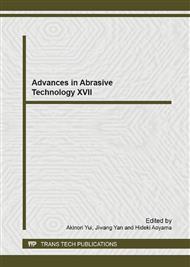[1]
B. Zhang, T.D. Howes, Material-Removal Mechanisms in Grinding Ceramics, Ann. CIRP. 43(1)(1994)305-308.
DOI: 10.1016/s0007-8506(07)62219-7
Google Scholar
[2]
Guangxiu Zhang, Bin Lin and Zhenpeng Shi, Study on the Correlativity between Grinding Parameters and Surface Residual Stresses in Ceramic, Key Eng. Mater. 4(2008)480-484.
DOI: 10.4028/www.scientific.net/kem.375-376.480
Google Scholar
[3]
S.S. Chiang, D.B. Marshall, A.G. Evans, The Response of Solids to Elastic/Plastic Indentation II. Fracture Initiation, J. Appl. Phys. 53(1)(1982)312-317.
DOI: 10.1063/1.329932
Google Scholar
[4]
T.G. Bifano, T.A. Dow, Scattergood R 0. Ductile-Regime Grinding: A New Technology for Machining Brittle Materials, Trans. ASME. 13(1991)184-189.
DOI: 10.1115/1.2899676
Google Scholar
[5]
B. Zhang, T.D. Howes, Subsurface Evaluation of Ground Ceramics, Ann. CIRP. 44(1)(1995)263-267.
Google Scholar
[6]
D.B. Marshall, Geometric Effects in Elastic/Plastic Indentation, J. Amer. Ceram. Soc. 67 (1984)57-60.
Google Scholar
[7]
B.R. Lawn, A.G. Evans, A Model for Crack initiation in Elastic/Plastic Indentation Field, J. Mater. Sci. 12(1977)2195-2199.
DOI: 10.1007/bf00552240
Google Scholar
[8]
S. Malkin, R.B. Anderson, Thermal aspects of grinding, Part I: Energy partition, ASME J. Eng. Ind. 96 (1974)1177-1183.
DOI: 10.1115/1.3438492
Google Scholar
[9]
Kun Li, T.W. Liao, Modeling of ceramic grinding processes part I: number of cutting points and grinding forces per grit, J. Mater. Process. Technol. 65(1-3)(1997)l-l0.
DOI: 10.1016/0924-0136(95)02232-5
Google Scholar
[10]
B.R. Lawn, A.G. Evans, D.B. Marshall, Elastic/Plastic Indentation Damage in Ceramics: The Median/Radial Crack System, J. Amer. Ceram. Soc. 63(1980)574-581.
DOI: 10.1111/j.1151-2916.1980.tb10768.x
Google Scholar
[11]
Xiaotian Li, Fanghong Sun, Measurement and analysis of laser scanning appearance of grinding wheel surface of resin bond, J. Mech. Sci. Technol. 20(1)(2001) 115-116.
Google Scholar
[12]
S. Malkin, Grinding Technology Theory and Applications of Machining with Abrasives, Ellis Horwood, Chichester, UK, (1989).
Google Scholar


